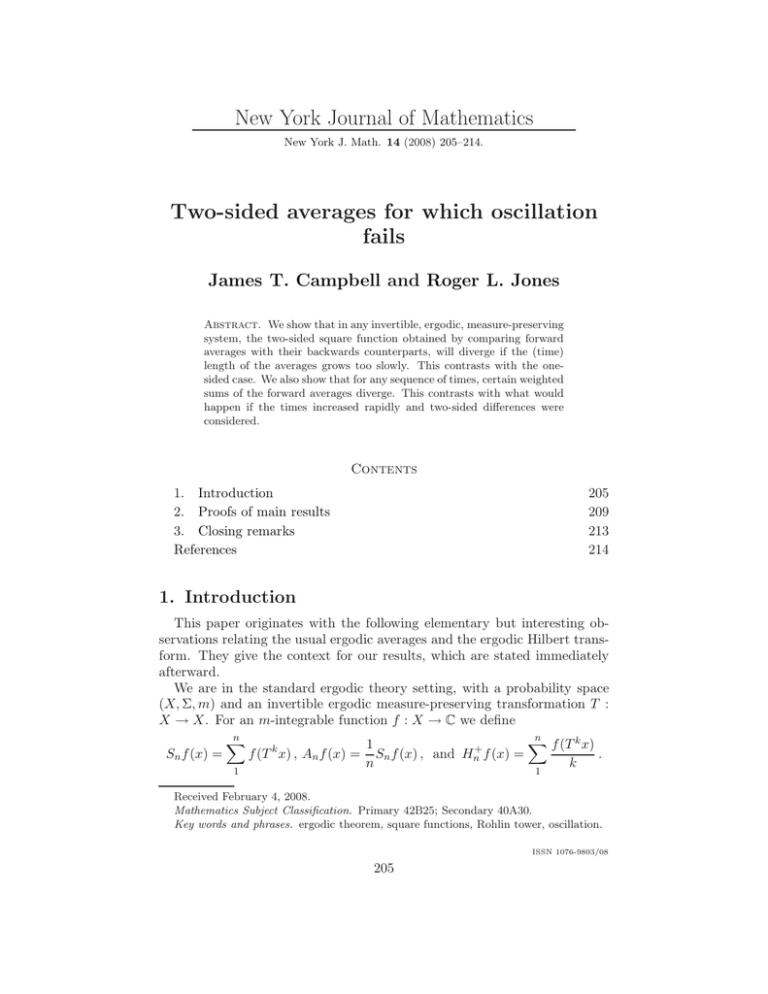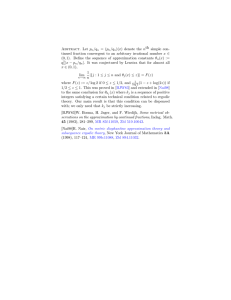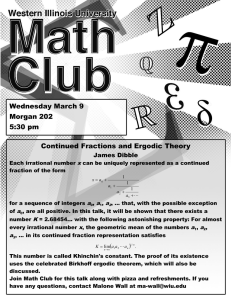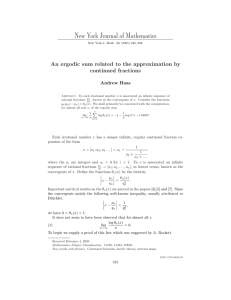New York Journal of Mathematics Two-sided averages for which oscillation fails
advertisement

New York Journal of Mathematics
New York J. Math. 14 (2008) 205–214.
Two-sided averages for which oscillation
fails
James T. Campbell and Roger L. Jones
Abstract. We show that in any invertible, ergodic, measure-preserving
system, the two-sided square function obtained by comparing forward
averages with their backwards counterparts, will diverge if the (time)
length of the averages grows too slowly. This contrasts with the onesided case. We also show that for any sequence of times, certain weighted
sums of the forward averages diverge. This contrasts with what would
happen if the times increased rapidly and two-sided differences were
considered.
Contents
1. Introduction
2. Proofs of main results
3. Closing remarks
References
205
209
213
214
1. Introduction
This paper originates with the following elementary but interesting observations relating the usual ergodic averages and the ergodic Hilbert transform. They give the context for our results, which are stated immediately
afterward.
We are in the standard ergodic theory setting, with a probability space
(X, Σ, m) and an invertible ergodic measure-preserving transformation T :
X → X. For an m-integrable function f : X → C we define
n
n
1
f (T k x)
k
+
.
f (T x) , An f (x) = Sn f (x) , and Hn f (x) =
Sn f (x) =
n
k
1
1
Received February 4, 2008.
Mathematics Subject Classification. Primary 42B25; Secondary 40A30.
Key words and phrases. ergodic theorem, square functions, Rohlin tower, oscillation.
ISSN 1076-9803/08
205
206
J. Campbell and R. Jones
Applying elementary summation by parts1 one sees that
Hn+ f (x) =
(1.1)
=
n−1
k=1
n−1
k=1
1
1
· Sk f (x) + An f (x)
k+1 k
1
Ak f (x) + An f (x) .
k+1
The astute reader has noted
that since+T is ergodic, An f (x) → f for
almost every x and hence, if f = 0, Hn f (x) will diverge almost surely.
This of course has been known for some time, but the above calculation
gives the simplest proof we know of this fact.
We remark in passing that Hn+ f (x) will converge almost surely for certain
functions with zero integral, for example if f = g − g ◦ T where g is bounded.
But even in the zero integral case Hn+ f (x) does not always converge; in
fact determining the class of functions f for which Hn+ f (x) converges is
extensively studied, and may depend upon T ; see for example [4].
It is also well-known that if we consider instead the symmetric averages
Hn f (x) =
0<|k|≤n
f (T k x)
,
k
then Hn f (x) converges almost surely, and the limit Hf is called the ergodic
Hilbert transform of f .
We may naively explore what summation by parts reveals in the two-sided
case — hoping perhaps for the appearance of a convergent series which might
lead to a simple proof of the a.e.-convergence of Hf (x).
n
1
f (T −k x). Then
Set A−n f (x) =
n
k=1
(1.2)
0<|k|≤n
f (T k x)
k
=
n−1
j=1
1
[Aj f (x) − A−j f (x)] + {An f (x) − A−n f (x)} .
j+1
Already we may derive something interesting from (1.2), even though it
diverts us from our main development.
Since Hn f (x) and the differences {An f (x) − A−n f (x)} converge almost
everywhere, it must be the case that the the first sum on the r.h.s. of (1.2)
converges a.e.. On the other hand, if we replace A−n f (x) with its limit f
1
For complex sequences (ak ) , (bk ) if Sj =
bk+1 ) + bn Sn .
Pj
k=1
ak then
Pn
k=1
a k bk =
Pn−1
k=1
Sk (bk −
Two-sided averages for which oscillation fails
207
then that sum becomes
n−1
n−1
1 1
Aj f (x) − f =
Aj f − f (x) .
j+1
j+1
j=1
j=1
We remind the reader of the following result due to Kakutani and Petersen
(1981), which gives a precise sense in which there is no general rate of
convergence in the pointwise Ergodic Theorem:2
Theorem 1.1 (Kakutani and Petersen [9]). If bk ≥ 0 and
bk = ∞ then
there exists f ∈ L∞ with f = 0 so that
L
bk Ak f (x)
= ∞ a.e.
sup L k=1
Thus we see that we can always find an f so that the modified sum
n−1
1
Aj f − f (x)
j+1
j=1
diverges to infinity; yet, the original sum
n−1
j=1
1
[Aj f (x) − A−j f (x)]
j+1
must converge a.e. for all integrable f (by the known a.e. convergence for
Hn f ). This says that
somehow A−j f (x) is a better predictor for Aj f (x) than
its eventual limit f . It would be interesting to have a better understanding
of why this is so.
Returning to our main development, our wish was to show directly that
the r.h.s. of (1.2) converges almost everywhere, which would provide a proof
of the a.e. convergence of Hn f (x). The term {An f (x) − A−n f (x)} on the
r.h.s. is certain to converge
almost surely, which leaves the task of showing
1
directly that the sum n−1
j=1 j+1 [Aj f (x) − A−j f (x)] converges. If we knew,
for example, that3
Sf (x)2 =
∞
|Aj f (x) − A−j f (x)|2 < ∞ (a.e.),
j=1
then an application of the Cauchy–Schwartz inequality to the first term on
the r.h.s. of (1.2) would give our new proof of the a.e. convergence for the
Hilbert transform. The connotation Sf refers to square function, and one
might be optimistic that the desired convergence would hold, because of
previous results on square functions in ergodic theory . More precisely it is
2
3
For a related, categorical-type negative result, see Corollary 3.4 of [5].
Note the difference between Sf and Sf .
208
J. Campbell and R. Jones
shown in [7] that for any increasing subsequence (nk ) of natural numbers,
and any f ∈ L1 , the square function
1
∞
2
2
|Ank f (x) − Ank+1 f (x)|
(1.3)
k=1
is finite a.e.. This is a one-sided result (only involving positive powers of T ),
but if we define the two-sided square function induced by (nk ) as
⎛
⎞1
2
∞
2
⎝
⎠
,
Anj f (x) − A−nj f (x)
S(nk ) f (x) =
j=1
then it follows from results in [6] that
∞
1
2
|A2n f (x) − A−2n f (x)|2
S(2k ) f (x) =
n=1
is finite a.e. for each f ∈ L1 . (In fact f → S(2k ) f will satisfy strong (p,p)
inequalities for 1 < p < ∞ and a weak (1,1) inequality, as will the original
one-sided square function (1.3)). The proof is based upon transfering the
setting to the integers, adding and subtracting a suitable dyadic martingale,
getting favorable estimates on the differences, and using known results for
square functions on martingales. See [6] for details.
Unfortunately for our original pursuit of a simple, direct proof of convergence for Hn f , our results show that there is indeed something special
about one-sided averages, and lacunary sequences:
Theorem 1.2. There exists f ∈ L∞ so that Sf (x) = ∞ a.e.
Corollary 1.3. f → Sf is unbounded on any Lp , 1 < p < ∞.
Actually these results are corollaries of the theorem we prove (Theorem 2.1), which gives sufficient conditions on sequences (nk ) so that S(nk ) f
will diverge. The statement is technical and thus omitted from the introduction, but the main point is relayed by Theorem 1.2 and Corollary 1.3.
Additionally we prove the following:
sequence of positive integers.
Theorem 1.4. Let (nk ) be any increasing
Then there exists an f ∈ L∞ with f = 0 for which
∞ Snk f (x) p
nk log k = ∞ a.e. for all 1 < p < ∞.
k=1
Again, this is interesting because of the fact that if we take (nk ) lacunary
and instead of subtracting the expected value, we subtract the backward
Two-sided averages for which oscillation fails
209
averages we get the positive result
∞ Snk f (x) − S−nk f (x) 2
< ∞ a.e., f ∈ L1 ,
n
k=1
k
by comparison with a suitable martingale.
2. Proofs of main results
We first state and prove Theorem 2.1, then outline how to obtain Theorem 1.2 and Corollary 1.3 as corollaries. Finally we prove Theorem 1.4.
As in the introduction we have a probability space (X, Σ, m) and an invertible ergodic measure-preserving transformation T : X → X. For an
m-integrable function f : X → C and n > 0 we define
n
f (T k x),
Sn f (x) =
1
1
An f (x) = Sn f (x),
n
n−1
1
f (T −n x).
A−n f (x) =
n
k=0
Fix a strictly increasing function φ on Z+ with the property that given
B > 0 there are infinitely many n ∈ Z+ such that φ−1 (4φ(n))−φ−1 (2φ(n)) >
B. Let Ψ be a strictly increasing function on [0, ∞) such that Ψ(0) = 0 and
limx→∞ Ψ(x) = ∞. Define
∞
Ψ(
Aφ(n) f (x) − A−φ(n) f (x)
) .
SΨ f (x) = Ψ−1
n=1
Theorem 2.1. If Ψ and φ are as above then there is a function f ∈ L∞
such that SΨ f (x) = ∞ almost surely.
Remark 2.2. A typical example of a φ that satisfies the above condition
is φ(n) = np for some p > 0, and a typical example of a Ψ is Ψ(x) =
x2 . In particular, if we take p = 1 we get a two-sided analogue of the
1
∞
2
2
|Ank f (x) − Ank+1 f (x)|
.
classical one-sided ergodic square function
k=1
As previously mentioned, it is shown in [7] that the one-sided square function
converges almost surely regardless of the choice of sequence (nk ), yet here
we will see that the two-sided analogue fails to do so for certain choices of
(nk ) (determined by φ(n)).
An example of a φ that does not satisfy the above condition is φ(n) = 2n ,
since then φ−1 (4φ(n)) − φ−1 (2φ(n)) = log2 (4 × 2n ) − log2 (2 × 2n ) = log2 4 −
log2 2 = 1, and we see that the required condition for φ fails for any B > 1.
210
J. Campbell and R. Jones
In general as φ increases more rapidly, φ−1 increases more slowly, so
that functions φ satisfying the above condition may be thought of as slowly
increasing.
Proof of Theorem 2.1. First we show, using a straightforward Rohlin
tower construction, that there is a function f ∈ L∞ such that SΨ f (x) = ∞
1
on a set of measure at least 10
. The general result will follow by choosing
the towers independently, as discussed at the end of the proof.
Fix any increasing integer sequence (nj ) satisfying n1 = 1 and the following properties:
4φ(nj )
1
(P1) n1k k−1
< 10k+1
.
j
j=1 10
(P2) Ψ−1 ( 12 101k ) · φ−1 (4φ(nk )) − φ−1 (2φ(nk )) > k.
For each j ∈ N form a Rohlin tower of height 16φ(nj ) and error less than
1
.
j Let
⎧
1
⎪
⎨ 10j if x is in the bottom half of the tower;
−1
fj (x) = 10
if x is in the top half of the tower;
j
⎪
⎩
0
if x is in the error set.
Write
f (x) =
∞
fj (x).
j=1
∞
Let αk (x) = k−1
j (x) and βk (x) =
j=1 f
j=k+1 fj (x).
∞ 1
1
Clearly f ∞ ≤ j=1 10j = 9 , so f ∈ L∞ as required.
For fixed k ∈ N define
Rk = {(, n) : 0 < ≤ φ(nk ), φ−1 (2φ(nk )) < n < φ−1 (4φ(nk ))},
and
Bk+
= {x : x is steps above the center of the kth tower, for some ∈ Rk }.
(Since the height of the tower is even, = 1 means we are on the first level
for which f (x) has a negative value.)
Fix (, n) ∈ Rk and x ∈ Bk+ at height . We estimate
|Aφ(n) f (x) − A−φ(n) f (x)|
as follows. We have Aφ(n) f (x) = Aφ(n) αk (x) + Aφ(n) fk (x) + Aφ(n) βk (x) and
similarly for A−φ(n) f (x). Hence
|Aφ(n) f (x) − A−φ(n) f (x)|
≥ Aφ(n) αk (x) + Aφ(n) fk (x) + Aφ(n) βk (x)
−A−φ(n) αk (x) − A−φ(n) fk (x) − A−φ(n) βk (x)
≥ Aφ(n) fk (x) − A−φ(n) fk (x)
− Aφ(n) αk (x)
− Aφ(n) βk (x)
− A−φ(n) αk (x)
− A−φ(n) βk (x)
.
Two-sided averages for which oscillation fails
211
We will show that (for fixed (, n) ∈ Rk and x ∈ Bk+ at height ) the first
term is the dominant term, and the others are comparatively small.
−1
The forward average, Aφ(n) fk is 10
k since because of our restriction on
(, n) we only see negative terms. The backward average is
1 φ(n) − 2
1
2
1 (φ(n) − ) − = k
= k 1−
.
10k
φ(n)
10
φ(n)
10
φ(n)
Thus (for fixed (, n) ∈ Rk and x ∈ Bk+ at height ) we see that
1
2
.
A−φ(n) fk (x) ≥ k 1 −
10
φ(n)
Since for (, n) ∈ Rk we have φ(n) > 2 we see that
Aφ(n) fk (x) − A−φ(n) fk (x)
≥ 1 −1 − 1 − 2 ≥ 1 .
k
10
φ(n) 10k
Now we need estimates on the four “error” terms. We have
Aφ(n) αk (x) ≤
k−1
k−1
j=1
j=1
8φ(nj )
1 8φ(nj )
1
≤
j
φ(n)
10
2φ(nk )
10j
1 1
and this is less than 10
by (P1).
10k
Clearly A−φ(n) αk (x) will satisfy the same estimate.
n
1 1
We also have Aφ(n) βk (x) ≤ n1 ∞
j=k+1 10j ≤ 9 10k , and the same for
A−φ(n) βk . Thus
Aφ(n) f (x) − A−φ(n) f (x)
≥ 1
10k
1
1
1−2 −2
10
9
≥
1 1
.
2 10k
Thus
∞
n=1
≥
Ψ(|Aφ(n) f (x) − A−φ(n) f (x)|)
{n:(,n)∈Rk }
Ψ
1 1
2 10k
1 1
#{n : (, n) ∈ Rk }
≥Ψ
2 10k
1 1
× φ−1 (4φ(nk )) − φ−1 (2φ(nk ))
=Ψ
k
2 10
> k.
Thus for each x ∈ Bk+ we have SΨ f (x) ≥ k. This estimate also will hold
on the set
Bk− = {x : x is steps below the center of the kth tower, for some ∈ Rk },
212
J. Campbell and R. Jones
2φ(nk )
1
≥ 10
if
and thus also on Bk = Bk+ ∪ Bk− , a set of measure (1 − k1 ) 16φ(n
k)
k > 5.
1
.
Since k is arbitrary we see that SΨ f (x) = ∞ on a set of size at least 10
We complete the proof as follows. Let Lk (Mj ) denote the Lth (M th)
rung in the kth (jth) tower. If the levels in the distinct towers were (probabilistically) independent, i.e., m(Lk ∩ Mj ) = m(Lk )m(Mj ), then by the
second Borel–Cantelli Lemma, m{x : x ∈ Bk infinitely often } = 1. But
in fact such towers may be constructed; see [10], p. 32, especially exercise
166 and the development of that exercise. The exercise states that a tower
may be constructed with the levels independent of any given partition of
the space. We apply that by considering the partition given by the common
refinement of the first j towers, as we construct the (j + 1)st tower.
Proof of Theorem 1.4. Fix the natural number subsequence (nk ), and let
bj denote a to-be-determined nonnegative, nonsummable real sequence. We
may suppose bj = 0 unless j = nk for some k. From the Kakutani–Petersen
∞ with
f = 0 so that
result
(Theorem
1.1)
there
is
an
associated
f
∈
L
L
bk Ak f (x)
= ∞ a.e.. By the sparseness of bj , the only terms that
sup L k=1
appear in the above sum are those that correspond to averages of length nk ,
so we just set Bk = bnk and have that
L
Snk f (x) Bk
sup = ∞ for a.e. x.
nk L k=1
Now write Bk = αk βk where
∞
q
k=1 βk
< ∞ for all q > 1. Then we have
L
L
Snk f (x) Snk f (x) Bk
βk αk
sup = sup nk nk L L k=1
k=1
≤ sup
L
L
≤
∞
k=1
k=1
1q L p 1p
S
f
(x)
αk nk
βkq
n
k=1
k
1 ∞ 1
q
Sn f (x) p p
q
αk k
βk
nk k=1
∞ 1
Sn f (x) p p
αk k
≤C
.
nk k=1
We know that for a.e. x the left-hand side is infinite, and consequently
the same is true for the right-hand side. As an example, take βk = k1 and
αk = log1 k .
Two-sided averages for which oscillation fails
213
This result has the advantage of an interesting conclusion with a relatively
easy proof, given the Kakutani–Petersen result. Using a more complicated
argument, with a tower construction similar to the proof of Theorem 2.1,
we can prove the following stronger result when p = 2:
sequence of positive integers.
Theorem 2.3. Let (nk ) be any increasing
Then there exists an f ∈ L∞ with f = 0 for which
∞ Snk f (x) 2
n √k = ∞ a.e..
k
k=1
We thank Máté Wierdl for pointing this out to us.
3. Closing remarks
Theorems 1.4 and 2.3 give quantitative descriptions of how the backwards
averages A−nk f (x), are a better predictor of the forward averages Ank f (x)
than the eventual limit f , at least when (nk ) is rapidly increasing. Theorem 1.2 shows that no advantage is gained in the case of slowly increasing
(nk ). It would be interesting to have a qualitative explanation for this.
Also, while the Kakutani–Petersen result is a negative statement about
speed of convergence for the averages Aj f (x), the averages do not oscillate
very much. For example, the following may be found found in [6].
Let gn be a sequence of Lp functions, say. For a sequence n1 < n2 < . . .
of natural numbers define the transformation O = Onk by
(3.1)
O(x) =
∞
k=1
1
sup
nk ≤n<nk+1
|gn (x) − gnk (x)|2
2
.
This is known as the oscillation operator, and for a given x, the finiteness
of O(x) (for all subsequences (nj ) implies, for example, the convergence of
gn (x) (n → ∞). On the other hand, it is easy to construct examples of
sequences of functions gn (x) which converge to 0 a.e., yet for which there is
a subsequence (nk ) for which Onk (x) is infinite a.e..
However, in the usual ergodic theory setting there is the following positive
result:
Theorem 3.1 ([6]). Let T be any measure-preserving transformation on
any probability space (X, B, m). For f ∈ Lp , set gn (x) = An f (x) in (3.1),
and write O(x) = Of (x). Then the map f → Of (x) is weak-type (1, 1), type
(p, p) for 1 < p < ∞, and maps L∞ to BMO.
In particular the oscillation is finite a.e., for every f ∈ L∞ . Thus, while
the rate of convergence is slow, the aim is fairly true.
214
J. Campbell and R. Jones
References
[1] Burkholder, D. L.; Davis, B. J.; Gundy, R. F. Integral inequalities for convex functions of operators on martingales. Proc. Sixth Berkeley Symp. Math. Statist.
Prob. (Univ. California, Berkeley, Calif., 1970/1971), Vol. II: Probability theory, pp.
223–240. Univ. California Press, Berkeley, Calif., 1972. MR0400380 (53 #4214),
Zbl 0253.60056.
[2] Campbell, James T.; Jones, Roger L.; Reinhold, Karin; Wierdl, Máté.
Oscillation and variation for the Hilbert transform. Duke Math. J. 105 (2000) 59–83.
MR1788042 (2001h:42021), Zbl 1013.42008.
[3] Campbell, James T.; Jones, Roger L.; Reinhold, Karin; Wierdl, Máté.
Oscillation and variation for singular integrals in higher dimensions. Trans. Amer.
Math. Soc. 355 (2003) 2115–2137. MR1953540 (2003j:44007), Zbl 1022.42012.
[4] Cohen, Guy; Lin, Michael. Laws of large numbers with rates and the one-sided
ergodic Hilbert transform. Illinois J. Math. 47 (2003), no. 4, 997–1031. MR2036987
(2005a:47014), Zbl 1037.60028.
[5] del Junco, Andrés; Rosenblatt, Joseph. Counterexamples in ergodic theory
and number theory. Math. Annalen 245 (1979) 185–197. MR0553340 (81d:10042),
Zbl 0398.28021.
[6] Jones, Roger L.; Kaufman, Robert; Rosenblatt, Joseph M.; Wierdl, Máté.
Oscillation in ergodic theory. Erg. Th. & Dyn. Sys. 18 (1998) 889–936. MR1645330
(2000b:28019), Zbl 0924.28009.
[7] Jones, Roger L.; Ostrovskii, Iosif V.; Rosenblatt, Joseph M. Square functions in ergodic theory. Ergod. Th. & Dynam. Sys. 16 (1996) 267–305. MR1389625
(97f:28044), Zbl 0854.28007.
[8] Jones, Roger L.; Rosenblatt, Joseph M.; Wierdl, Máté. Oscillation in ergodic
theory: higher-dimensional results. Israel Journal of Mathematics 135 (2003) 1–27.
MR1996394 (2004h:37005), Zbl 1052.28010.
[9] Kakutani, Shizuo; Petersen, Karl. The speed of convergence in the ergodic
theorem. Monatsh. Math. 91 (1981) 11–18. MR0612450 (82g:28022), Zbl 0446.28015.
[10] Kalikow, S.; McCutcheon, R. Overview of ergodic theory.
http://campbeljpc2.msci.memphis.edu/papers/kalfixed.dvi.
[11] Lepingle, D. La variation d’order p des semimartingales. Z. Wahrscheinlichkeitstheorie verw. Gebiete 36 (1976) 295–316. MR0420837 (54 #8849), Zbl 0325.60047.
[12] Petersen, Karl. Ergodic theory. Cambridge Studies in Advanced Mathematics,
2. Cambridge University Press, Cambridge, 1983. ISBN: 0-521-23632-0. MR0833286
(87i:28002), Zbl 0507.28010.
(J. Campbell) Department of Mathematical Sciences, Dunn Hall 373, University
of Memphis, Memphis, TN 38152
jtc@campbeljpc2.msci.memphis.edu
(R. Jones) Conserve School, 5400 N. Black Oak Lake Road, Land O’Lakes, WI
54540
rjones@condor.depaul.edu
This paper is available via http://nyjm.albany.edu/j/2008/14-8.html.



